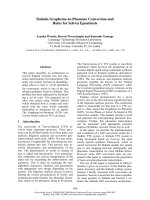Color and Mastering for Digital Cinema pot
Bạn đang xem bản rút gọn của tài liệu. Xem và tải ngay bản đầy đủ của tài liệu tại đây (4.25 MB, 202 trang )
Color and Mastering for Digital Cinema
Prelims-K80874.qxd 9/19/06 4:41 PM Page i
This page intentionally left blank
Color and Mastering
for Digital Cinema
Glenn Kennel
Digital Cinema Industry
Handbook Series
Charles S. Swartz
AMSTERDAM • BOSTON • HEIDELBERG • LONDON
NEW YORK • OXFORD • PARIS • SAN DIEGO
SAN FRANCISCO • SINGAPORE • SYDNEY • TOKYO
Focal Press Is an Imprint of Elsevier
Prelims-K80874.qxd 9/28/06 12:08 PM Page iii
Cover photograph: Standard Evaluation Material (StEM) picture by permission of the American Society of
Cinematographers (ASC) and Digital Cinema Initiatives (DCI). Color Timing Theatre is courtesy of
Laser Pacific Media Corporation.
Acquisitions Editor: Angelina Ward
Series Editor: Charles S. Swartz
Technical Editor: Sarah Priestnall
Project Manager: Paul Gottehrer
Assistant Editor: Doug Shults
Marketing Manager: Christine Degon Veroulis
Cover Design: Alisa Andreola
Interior Design: Isabella Piestrzynska
Focal Press is an imprint of Elsevier
30 Corporate Drive, Suite 400, Burlington, MA 01803, USA
Linacre House, Jordan Hill, Oxford OX2 8DP, UK
Copyright © 2007, Elsevier Inc. All rights reserved.
No part of this publication may be reproduced, stored in a retrieval system, or transmitted in
any form or by any means, electronic, mechanical, photocopying, recording, or otherwise,
without the prior written permission of the publisher.
Permissions may be sought directly from Elsevier’s Science & Technology Rights
Department in Oxford, UK: phone: (+44) 1865 843830, fax: (+44) 1865 853333,
E-mail: You may also complete your request on-line
via the Elsevier homepage (), by selecting “Support & Contact”
then “Copyright and Permission” and then “Obtaining Permissions.”
Recognizing the importance of preserving what has been written, Elsevier prints its books on
acid-free paper whenever possible.
Library of Congress Cataloging-in-Publication Data
Application submitted
British Library Cataloguing-in-Publication Data
A catalogue record for this book is available from the British Library.
ISBN 13: 978-0-240-80874-1
ISBN 10: 0-240-80874-6
For information on all Focal Press publications
visit our website at www.books.elsevier.com
0607080910 10987654321
Printed in Canada
Prelims-K80874.qxd 9/19/06 4:41 PM Page iv
To Sarah and Lucy
Prelims-K80874.qxd 9/19/06 4:41 PM Page v
This page intentionally left blank
Contents
Preface ix
Acknowledgments xi
About the Author xiii
About the Series Editor xv
1 Overview of Color and Mastering for Digital Cinema 1
2 Color in Motion Picture Film 9
3 Color Space for Digital Cinema 33
4 Transfer Function 47
5 Reference Projector and Environment 67
6 Digital Mastering 85
7 Color Encoding for Digital Cinema Distribution 105
8 Color Processing in the Projector 119
9 DLP Cinema® Case Study 131
10 Digital Display Technologies 145
11 Digital 3D Presentation 157
12 The Future 169
Index 181
vii
Prelims-K80874.qxd 9/19/06 4:41 PM Page vii
This page intentionally left blank
Preface
The standardization of 35 mm film nearly 100 years ago paved the way for the growth of the
motion picture industry. From its humble roots in nickelodeons and peep shows, the motion pic-
ture business evolved into popular entertainment for the masses. Along the way, the 35mm film
standard was extended to support sound, color, wide screen presentation, and multi-channel
digital soundtracks.
The film-making process is being revolutionized by the adoption of digital imaging technologies.
Digital post production was widely embraced in the 1990s, and digital cinema distribution and
exhibition is now taking off with a consensus standard supported by all of the major studios.
This book describes the color mastering and encoding methods for digital cinema, looking back
at the traditional film process, providing insight into the evolving digital intermediate process,
and reviewing the basis for the color encoding standards for digital cinema distribution. One can
only hope that these digital cinema standards can be as capable and enduring as 35 mm film.
ix
Prelims-K80874.qxd 9/19/06 4:41 PM Page ix
This page intentionally left blank
Acknowledgments
I could not have written this book without the help of many people. First, I’d like to thank my wife,
Sarah Priestnall, for checking my writing and correcting my mistakes, and also for helping me re-
write sections for clarity, particularly the chapter on Digital Intermediate. I also thank her for her
support and patience while I was spending many weekends on the writing.
I am deeply indebted to Tom Maier of Kodak for his lucid writing on the subject of color pro-
cessing for digital cinema. In particular, much of Chapters 3, 4, 7, and 8 are based on documents
that he wrote as a leading contributor to the SMPTE DC28 Color ad hoc group.
I also thank Matt Cowan of Real D for his contributions as a member of the SMPTE DC28 Color
ad hoc group, and for his help in reviewing and editing the chapter on Digital 3D. Matt also con-
tributed several illustrations to this book.
Brad Walker of Texas Instruments taught me a lot about the color processing that he designed for
the DLP Cinema® projectors, and much of Chapter 9 is based on a paper that he co-authored
with Greg Pettitt, also of Texas Instruments. Brad was also a key contributor to the SMPTE DC28
Color ad hoc group.
I’d also like to thank the other members of the SMPTE DC28 Color ad hoc group, who dedicated
many hours to our discussions and evaluations leading up to the specification of XЈYЈZЈ color
encoding for digital cinema distribution. This group also included Prinyar Boon, Chuck Harrison,
Jim Houston, George Joblove, Howard Lukk, Arjun Ramamurthy, Jeremy Selan, John Silva, Kaz
Tsujikawa, and Ron Williams.
xi
Prelims-K80874.qxd 9/19/06 4:41 PM Page xi
I’d like to thank industry consultant Peter Putman for his contributions to Chapter 10 on Digital
Display Technologies. Many of the illustrations in this chapter come from his tutorials to HPA
and NAB audiences.
And finally, I’d like to pay a special tribute to Walt Ordway, Howard Lukk, and Jim Whittlesey of
Digital Cinema Initiatives, who drafted the DCI System Specifications, and in the process built a
technical and political consensus amongst the major studios, enabling the deployment of digi-
tal cinema.
xii Acknowledgments
Prelims-K80874.qxd 9/19/06 4:41 PM Page xii
About the Author
Glenn Kennel has worked in technology development in the motion picture industry for over 25
years, pioneering the application of digital technology to the filmmaking process He started his
career with Eastman Kodak in 1980, and participated in the development of Kodak High Speed
Negative Film 5293.
In the mid-1980s, Kennel assembled a project team and led the development of a prototype
HDTV telecine that later provided the basis for the Philips Spirit Datacine. In 1989, he worked
with Industrial Light & Magic (ILM) to build the first linear CCD scanner for motion picture film
scanning.
Kennel was also the architect of the Cineon digital film system in 1990 and led the development
of the Cineon CCD film scanner and film recorder over the next couple of years. He helped launch
Kodak’s Cinesite Digital Film Center in 1992 and evangelized digital technology with the visual
effects industry. He also provided technical support to Cinesite during the digital restoration of
Disney’s Snow White.
In 1993, Glenn Kennel was recognized by SMPTE with the Agfa-Gaevert Gold Medal for out-
standing achievement in the field of film/television interface.
In 1995, he received the Academy Scientific and Technical Achievement award for the linear
CCD film scanner, jointly developed with ILM. He worked with Philips to extend the Spirit
Datacine to Cineon-compatible digital file output, first applying it to the film “Pleasantville”
in 1997. He helped establish Cinesite’s Digital Mastering department in 1998, providing technical
support to the first major feature film to go through the DI process, “O Brother, Where Art Thou?”
in 1999–2000.
xiii
Prelims-K80874.qxd 9/19/06 4:41 PM Page xiii
As program manager of Kodak’s Digital Cinema effort in 2000–2003, he led a team that developed
servers and software for digital cinema and coordinated a joint development program with JVC
for a digital cinema projector.
In 2003, Kennel left Kodak to work as an industry consultant with DCI on color encoding for dig-
ital cinema, including coordinating the digital mastering process for the ASC/DCI StEM test. He
chaired the SMPTE DC28 ad hoc group on Color and helped draft several digital cinema stan-
dards. He joined Texas Instruments’ DLP Cinema group in 2004, in a role that combined tech-
nology and business development for digital cinema, helping the industry address the practical
hurdles to digital cinema deployment.
Kennel was elected to the Scientific and Technical Branch of the Academy of Motion Picture Arts
and Sciences in 2005.
Kennel is now Vice President and General Manager of the Motion Picture division of Laser Pacific
Media Corporation, where he is responsible for services including digital dailies, previews,
Digital Intermediate, mastering and digital cinema packaging.
Kennel is the author of many technical papers on applications of digital technology to filmmak-
ing published in the SMPTE Journal, and co-author of a chapter in Understanding Digital Cinema
(2005). He is also a fellow of SMPTE.
xiv About the Author
Prelims-K80874.qxd 9/19/06 4:41 PM Page xiv
About the Series Editor
Charles S. Swartz oversees efforts to further the entertainment industry through new technology.
He draws from more than two decades of experience in feature film and television production,
academic programming and strategic consulting to lead the center in identifying emerging enter-
tainment technology issues and developing projects to study them. Swartz assumed his current
position at the Entertainment Technology Center in 2003, where he has refocused and recharged
the research center. He serves in two positions for SMPTE/Hollywood: Governor of the Hollywood
Region and co-chair of the education committee. In 1996, the Los Angeles Business Journal
named him one of 100 technology leaders in Los Angeles.
xv
Prelims-K80874.qxd 9/19/06 4:41 PM Page xv
This page intentionally left blank
1
Overview of Color and
Mastering for Digital
Cinema
In June of 1999, George Lucas released his film “Star Wars: Episode 1” on two digital cinema
screens—one in New York and one in Los Angeles. In the five years since this historic debut, over
150 films have been released digitally to over 500 screens in 30 countries around the world. These
digital movies have played over 20,000 shows to satisfied audiences. Although digital cinema has
not been widely promoted as a new and improved display method, educated audiences have shown
a preference for digital over film presentation.
This book presents a survey of the development of color encoding and decoding standards for dig-
ital cinema distribution and exhibition. It describes the key issues and provides background on
decisions that were made in the standardization process. Although the author was a key participant
in the development of the SMPTE
1
DC28 documents, it is recommended that the reader refer to the
published SMPTE standards
2
for the final word on implementation.
1
1. Society of Motion Picture and Television Engineers.
2. At the time of this writing, the SMPTE DC28 working group has several digital cinema documents in process.
These standards are available to participants, but have not yet been published.
CH01-K80874.qxd 9/18/06 9:52 AM Page 1
This book refers to colorimetric principles that are more rigorously defined in color textbooks
3,4
and assumes that the reader has a working knowledge of basic color principles and motion picture
industry practices. However, one does not need to be a color scientist or industry insider to read
and understand this book.
In late 1999, SMPTE established the DC28 working group to study the standardization requirements
for digital cinema distribution, with the goal of establishing a world-wide standard. Since its stan-
dardization by SMPTE in 1916, the 35 mm motion picture film format has served as the single world-
wide distribution standard for movies. 35 mm motion picture film has weathered the test of time,
supporting major exhibition enhancements like sound, color, widescreen presentation and multi-
track digital soundtracks, all compatible with 35 mm projection equipment based on the original
standard. In today’s hyper-competitive and fast-changing digital world, it seemed a tall order to
establish a digital cinema distribution standard that would serve the industry for the next century.
But the industry set its sights on just that. The goal was to develop a universal standard for digital
cinema distribution that could be implemented in a cost effective way today, while also extensible
to support future exhibition improvements.
The SMPTE DC28 group concluded its study work at the end of 2000 by identifying the need for
standards for digital cinema mastering, distribution and exhibition. Working groups were estab-
lished to address each of these areas. In addition, ad hoc groups of industry experts were formed
to address specific issues, including packaging, key management and security, and color. The DC28
color ad hoc group began its work in 2002, focusing its initial discussions on the color encoding for
digital cinema. The group was composed of experts from diverse parts of the industry that included
studios, post production facilities and equipment manufacturers. While everyone agreed on the
goal, there were many opinions on how best to get there.
While the SMPTE DC28 work proceeded slowly and steadily as a due process forum with diverse
interests, the establishment in 2002 of the Digital Cinema Initiatives, LLC (DCI), a consortium
formed by seven major Hollywood studios, provided a focus for the development of the digital cin-
ema standards. A group of technical experts from the member studios met regularly to hammer out
a consensus technical specification for digital cinema distribution. In its work, DCI used available
and prototypical digital cinema equipment to evaluate requirements for compression, security,
content packaging and color encoding. DCI hired several industry experts to supplement its inter-
nal expertise. Amongst other things, DCI funded the Contrast Sensitivity Test that verified the bit
depth requirement for color encoding (see Chapter 4).
Most importantly, DCI provided a venue for the political process of building consensus amongst
its members. Its crowning achievement was the delivery of a consensus technical specification for
2 1. Overview of Color and Mastering for Digital Cinema
3. R.W.B. Hunt,
The Reproduction of Color
, 6th Edition, Wiley, © 2004.
4. G. Wyszecki and W.S. Stiles,
Color Science: Concepts and Methods, Quantitative Data and Formulae
, 2nd Edition,
Wiley, © 2000.
CH01-K80874.qxd 9/18/06 9:52 AM Page 2
a 2 K/4 K scalable solution in July 2005 that was supported in its entirety by all of its members.
This consensus specification removed a substantial uncertainty, paving the way for commercial
deployment of compliant systems while substantially reducing the risk of technological
obsolescence.
Overview of Color and Mastering for Digital Cinema 3
STUDIO OBJECTIVES
CTO Brad Hunt of the Motion Picture Association of America (MPAA) framed the work
of DCI with the following ten goals:
1. ENHANCED THEATRICAL EXPERIENCE—The introduction of digital cinema must
be used by the motion picture industry as an opportunity to significantly enhance
the theatrical film experience and thus bring real benefits to theater audiences.
2. QUALITY—The picture and sound quality of digital cinema should present as accu-
rately as possible the creative intent of the filmmaker. To that end, its quality must
exceed the quality of a projected 35 mm “answer print” shown under optimum studio
screening theater conditions. Any image compression that is used should be visually
lossless.
3. WORLDWIDE COMPATIBILITY—The system should be based around global stan-
dards so that content can be distributed and played anywhere in the world as can be
done today with a 35 mm film print.
4. OPEN STANDARDS—The components and technologies used should be based on
open standards that foster competition amongst multiple vendors of equipment
and services.
5. INTEROPERABLE—Each of the components of the system should be built around
clearly defined standards and interfaces that insure interoperability between differ-
ent equipment.
6. EXTENSIBLE—The hardware used in the system should be easily upgraded as
advances in technology are made. This is especially important in evolving to higher
quality levels.
7. SINGLE INVENTORY—Once a consensus on digital cinema standards is reached and
implemented, upgrades to the system should be designed so that a single inventory
of content can be distributed and compatibly played on all equipment installations.
8. TRANSPORT—The system should accommodate a variety of secure content trans-
port mechanisms, including electronic as well as a physical media delivery.
C
CH01-K80874.qxd 9/18/06 9:52 AM Page 3
The objectives that must be considered in the selection of color encoding standards for digital
cinema distribution are an enhanced theatrical experience, with picture quality better than a film
answer print
5
, and open standards that are interoperable and extensible. And all of this must be sup-
ported by equipment and operational costs that are reasonable. In addition, since the transition to
digital distribution cannot happen overnight and will likely take 5 to 10 years, it is important that the
mastering process and the end product be compatible with traditional 35 mm film distribution and
exhibition practices.
This compatibility with 35 mm film locked down two major exhibition requirements: screen lumi-
nance and chromaticity. Creative color decisions that affect the look and feel of the picture are part
of the mastering process. For the creative intent to be faithfully reproduced on the cinema screen,
it is critical that the screen luminance and white point be standardized. And since movies will be
exhibited on both film and digital projectors for some time, it is critical that these parameters be
consistent in both venues. For compatibility with legacy film projectors, the digital cinema stan-
dards specify a screen luminance of 48 cd/m
2
(14 ft L) with a white point of 0.314 x, 0.351 y. The
basis for these parameters will be explained in Chapter 5.
This treatment of digital cinema color encoding will describe the standards and practices that are
used to create the digital cinema master, and those that are used to faithfully reproduce this mas-
ter in cinema exhibition. Since this process does not include color calibration or color encoding for
image origination, front-end production is excluded from this analysis. Instead, the book focuses
on the middle to the end of the process, as shown by the highlighted blocks in Figure 1.1, and
the color calibration and standards that support mastering and distribution. Origination, dailies,
4 1. Overview of Color and Mastering for Digital Cinema
9. SECURE CONTENT PROTECTION—The system must include a highly secure, end-to-
end, conditional access content protection system, including digital rights manage-
ment and content watermarking, because of the serious harm associated with the theft
of digital content at this stage of its distribution life cycle. Playback devices must use
on-line authentication with the decrypted content files never accessible in the clear.
10. REASONABLE COST—The system standards and mastering format(s) should be cho-
sen so that the capital equipment and operational costs are reasonable. All required
technology licenses should be available on reasonable and non-discriminatory terms.
5. An answer print is the first print that combines picture and sound and is a first generation graded print from the
original negative.
C
CH01-K80874.qxd 9/18/06 9:52 AM Page 4
editing and preview functions are outside of the scope of this book. Color encoding for digital cin-
ema distribution picks up in the digital mastering process (where the final color grading is per-
formed on a calibrated reference projector). The complimentary process of color decoding is
performed on a calibrated projector in the cinema.
Now, here’s a quick preview of the rest of the book.
Chapter 2, “Color in Film”, covers the color characteristics of the traditional motion picture film
system, starting with the exposure of an image on a color negative film. The extended range of a
typical negative film is described, along with typical placement of a white card and 18% gray for
normal and over-exposures. The characteristics of color print film are then described, along with
the “print-through” curves that result when a negative is printed onto print stock. The IP/IN
release printing process is discussed.
Chapter 3, “Color Space”, starts with a review of the basic characteristics of human vision, and
how color scientists have developed experimental methods to model it. After reviewing the
requirements for the selection of a color space for digital cinema, the various options are sum-
marized. The experimental basis for the CIE colorimetric analysis is reviewed, leading to the
standard x, y, z color matching functions and the X, Y and Z color primaries.
Chapter 4, “Transfer Function”, covers the definition of the non-linear (gamma 1/2.6) encoding
transfer function selected for digital cinema distribution. DCI conducted an experiment to verify
that the Barten model for contrast sensitivity applies to theatrical viewing conditions, and the
results of this test are described.
Chapter 5, “Reference Projector and Environment”, covers the definition of a reference projector
for digital cinema mastering and exhibition, for the purpose of insuring consistency from screen
Overview of Color and Mastering for Digital Cinema 5
Release
printing
Origination Dailies Editorial
Preview
screenings
Reference
projector
Digital
mastering
Digital
distribution
Film
distribution
Encoding and
packaging
Figure 1-1. Motion Picture Workflow.
CH01-K80874.qxd 9/18/06 9:52 AM Page 5
to screen. The important image attributes are defined along with appropriate tolerances for
mastering and exhibition. The calibration and measurement of digital cinema projectors is
reviewed, with a brief description of the instrumentation and test patterns required.
Chapter 6, “Digital Mastering”, reviews the evolving trends in mastering, including the widespread
adoption of a digital intermediate process that supports the digital conforming and grading of the
full feature film, while supporting outputs to everything from film release prints, to digital cinema
distribution masters (DCDMs) and home video masters. The workflow of the digital intermediate
process is reviewed, along with the choices of working resolution (2 K or 4 K) and color calibration
(film-centric or digital-centric).
Chapter 7, “Color Encoding for Digital Cinema Distribution”, describes the color transforms in con-
verting from the RGB mastering space to XYZ color encoding. The rationale for the output-referred
color encoding is reviewed. The draft SMPTE standards also include the definition of metadata
from the reference projector to facilitate gamut mapping downstream.
Chapter 8, “Projector Color Processing”, covers the processing requirements for a digital
cinema projector. Calibration is critical to provide consistency from screen to screen and over
time. When wider gamut projectors are introduced in the future, a gamut mapping capability
will need to be implemented in legacy projectors in order to maintain backward compati-
bility. Finally, the advantages of relative luminance encoding are reviewed in the context of a
practical test.
Chapter 9, “DLP Cinema — A Case Study” describes how the leading digital cinema projection
technology from Texas Instruments works, and its historical development in response to industry
needs. This includes an explanation of the color processing and calibration technology built into
DLP Cinema projectors.
Chapter 10, “Digital Display Technologies”, provides a brief overview of other display technologies
used in the professional and consumer markets. These include D-ILA™ and SXRD™ for digital pro-
jection, and LCD, plasma, and SED flat panel displays. The ubiquitous CRT reference monitor in
post production seems to be at the end of its run, but it is not clear which digital display technol-
ogy will replace it. The limitations of today’s displays are reviewed, along with some new tech-
niques that promise to overcome the shortcomings.
Chapter 11, “Digital 3D Presentation”, describes the history and fundamental technology behind
theatrical 3D presentation. The light efficiency of various options is compared, including dual
projectors with linear polarizers, single projector with shuttered glasses, single projector with
Z-screen™ active polarizer, and dual projectors with Infitec™ color bandpass filters.
6 1. Overview of Color and Mastering for Digital Cinema
CH01-K80874.qxd 9/18/06 9:52 AM Page 6
Chapter 12, “The Future”, reviews the driving forces behind the deployment of digital cinema sys-
tems and takes a stab at predicting how fast this may occur. The importance of alternative content
is reviewed along with the additional technical requirements. Digital cameras are just being intro-
duced that are beginning to challenge the dynamic range and color gamut of traditional motion
picture negative films, but the device-independent XYZ color encoding for digital cinema distribu-
tion can easily accommodate new image sources. Color appearance modeling techniques promise
to help automate the process of color conversion for different displays. Finally, the book concludes
with a brief discussion of the archival dilemma with digital storage technologies and some recom-
mendations on which elements to archive.
Overview of Color and Mastering for Digital Cinema 7
CH01-K80874.qxd 9/18/06 9:52 AM Page 7
This page intentionally left blank









